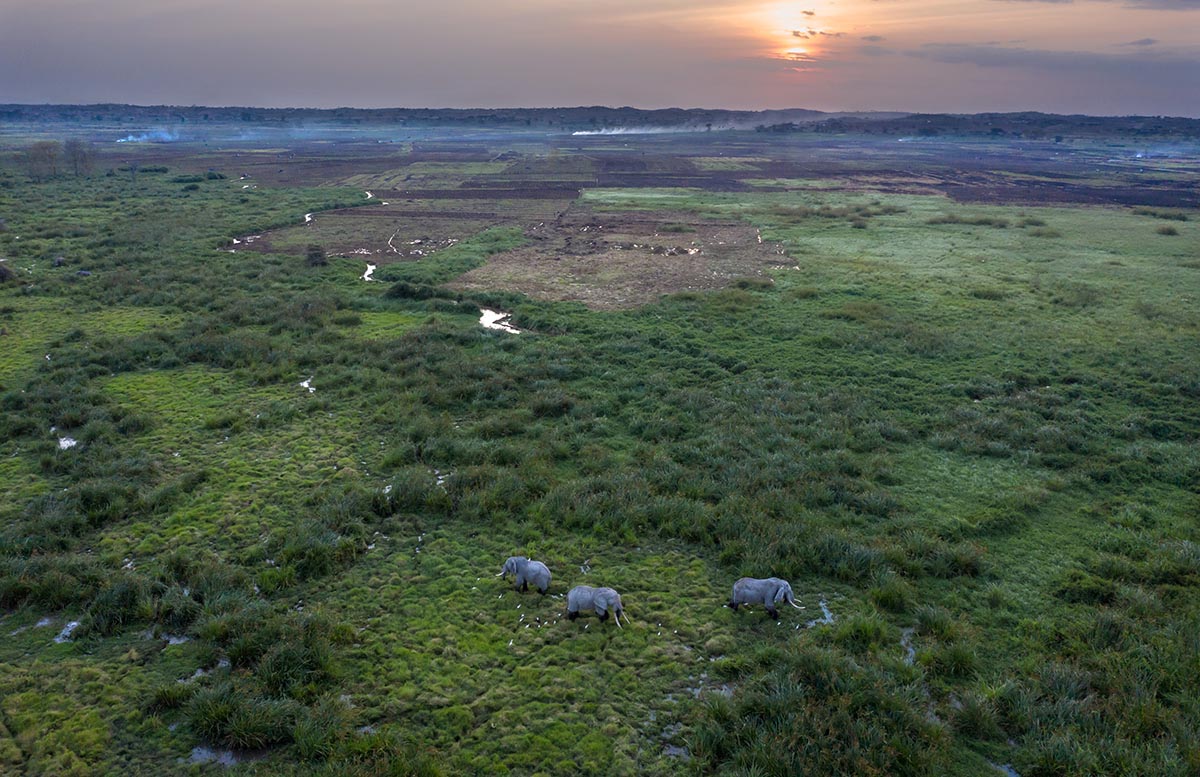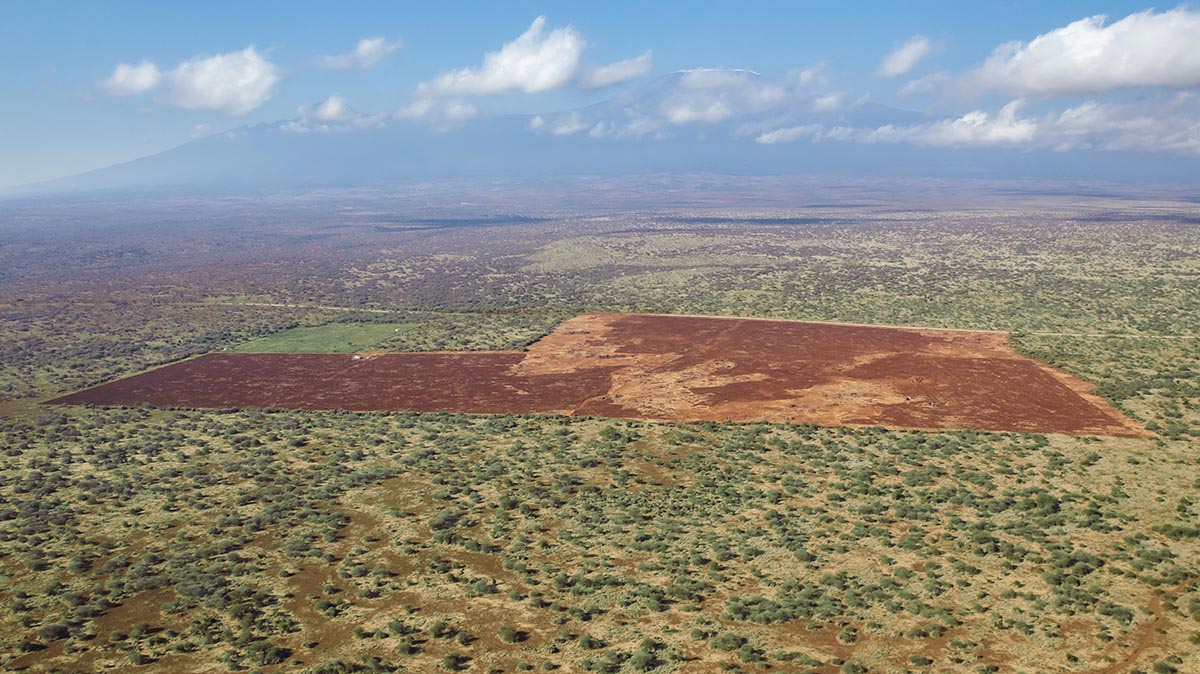
Some things kill elephants quickly; others kill them slowly.
A poacher’s bullet will do the first. As for the second, consider…. the avocado.
Equally deadly are the fine bean, the sugar snap, and the snow pea.
These are the luxury products of international agribusiness. The profits are big, and cash speaks much louder than elephants, or local communities for that matter. Many companies selling these products will stop at almost nothing as they relentlessly pursue expansion into the wildlife-rich rangelands of Kenya.
And before long come the bulldozers. We know, because we’ve just seen it happen.
In a matter of days, the machines cleared 180 acres of wildlife habitat, reducing it to bare earth in preparation for its future inhabitants: avocado trees.

A new battle for the Greater Amboseli ecosystem has begun, one of more potential consequence than poaching, which Big Life’s rangers have so successfully reduced over recent years.
It has started in the Kimana Wildlife Corridor, a critically important area where some of Amboseli’s most iconic bull elephants spend months of the year. It is the only remaining direct route for wildlife to travel between Amboseli and the southern part of Tsavo West National Park.
Following outcry from the local community and conservation groups, Kenya’s National Environment Management Authority announced its intention to revoke the license for the avocado farm. As we write, the case is being appealed in the National Environment Tribunal of Kenya and is now in court.
If the agricultural company wins, it will be an open invitation for developers to continue with the rapid destruction of Amboseli’s unique environment—one of only five UNESCO Biosphere Reserves in Kenya.
As it is, there is already another vegetable farm close by that was permitted last year for 120 acres of agricultural development, has since expanded to 540 acres.
Wildlife numbers across Kenya are declining steeply, and Amboseli is one of the last places in the country with healthy elephant populations, including some of the few remaining large tuskers and growing populations of species like lion, giraffe, and cheetah.
There is plenty of available arable land in Kenya where wildlife is already extinct.
Why destroy one of the last places in East Africa where herds of elephants still roam free?

These developments are also a direct threat to human beings. The Greater Amboseli ecosystem has a conservation and ecotourism industry that supports thousands of jobs and generates tens of millions of dollars for the local and national economies.
No one travels to Africa to look at fields of avocado trees.
The coming months and years are critical. The ecosystem primarily comprises large community-owned “group ranches,” which have always enabled freedom of movement for wildlife, humans, and livestock. The ability of animals to travel with the seasons in search of food and water, on ancient migratory paths, is essential for their survival.
But pressure is building for subdivision of the land. This transition from continuous community-owned landscape to private ownership of land by individuals threatens to shatter the ecosystem into tens of thousands of small 20, 40, and 60 acre plots.
These small plots will then be sold and converted to other uses, wildlife will run out of space, and the Greater Amboseli ecosystem’s wildlife populations will be decimated.
It will be difficult to preserve the ecosystem in its current state. Fortunately, there are key wildlife corridors and dispersal areas that we can still protect, which would allow the ecosystem to support similar wildlife numbers as at present.
But if things go wrong—if we don’t act now—we risk the collapse of the entire ecosystem.
Big Life has in the past taken on poaching, and been successful. We have taken on human-wildlife conflict, and been successful.
Now we get to the very crux of the matter: space.

To be blunt, there is no point in having hundreds of rangers patrolling for poachers, long fences to reduce conflict between elephants and farmers, and everything else Big Life does if there is no wild land left for the animals of this still-wonderful ecosystem to inhabit.
Securing wildlife corridors and dispersal areas is Big Life’s most urgent task, and it is possible, but there is no time to waste.
Land preservation can be a win-win for all—not just for the animals, but also for the local communities—and this is consistent with the holistic approach we’ve always taken.
One way of achieving this mutual benefit is land leasing. Land leasing maintains Maasai ownership of land, but restricts land conversion and fragmentation in exchange for payments to landowners.
This model keeps land natural and open to wildlife and livestock, while still allowing the landowners to generate income. And with protected habitat and wildlife come jobs in ecotourism and conservation.
Think of it as an Ecosystem Services Payment. Very unsexy, but utterly necessary if animals and ecosystems are to survive in the fast-changing and ever-more-crowded world of 21st Century Africa.

Over the decades, Big Life has successfully protected over 1.6 million acres in the Greater Amboseli ecosystem and the wildlife populations here. You have always been there to help us do it.
Our success lies in our ability to adapt and design innovative solutions to conservation challenges that support both people and wildlife. This is no different.
Big Life will protect the ecosystem’s most important natural habitats by:
Partnering with local communities during the subdivision process to identify and protect essential habitat areas for wildlife and livestock;
Designing, negotiating, and managing mutually beneficial land leases in critical land areas; and
Working with private sector partners to create inclusive ecotourism opportunities and generate additional sources of income for landowners.
However, projects like these are too big to tackle alone.
With great generosity, The D.N. Batten Foundation has committed to match every donation made, up to $100,000. This means your support will have double the impact. Now is an extremely important time for the future of this irreplaceable landscape, its wildlife, and its people. Please join us and donate.
As much as things may be changing now, and will surely again in future, our mission remains the same: to protect nature for the benefit of all in the Greater Amboseli ecosystem.
With gratitude,
Nick Brandt and Richard Bonham
